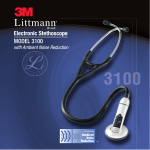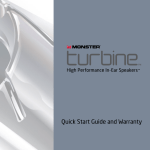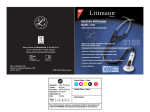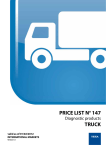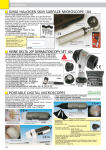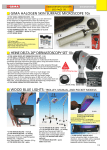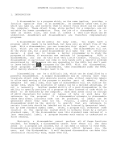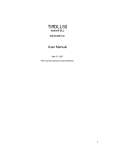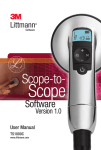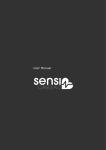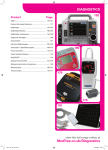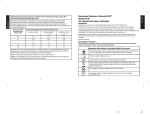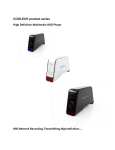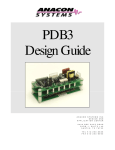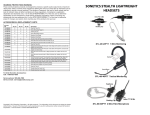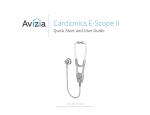Download Electronic Stethoscope
Transcript
Electronic Stethoscope MODEL 4100 with Ambient Noise Reduction Artwork No.: 38-9018-6521-2 Date: 7/21/05 Author: S Barker Supersedes: 38-9018-6474-4 Pkg Spec Ref: 34-7058-5474-2 Structure: Booklet Cover AMPLIFY AND RECORD THE SOUNDS YOU WANT TO HEAR WITH LESS DISTRACTING AMBIENT NOISE Made in Denmark for 3M Health Care, St. Paul, MN 55144 • Amplification up to 18 times greater than the best conventional Littmann stethoscopes (U.S.A.) 1 800 228-3957 • Fax 651 736-2803 Visit our web site: http://www.3M.com/Littmann • Reduction of unwanted ambient noise by up to 75% • Recording and playback capability Attention, see instructions for use. 0086 3M Health Care D-41453 Neuss, Germany • Playback capability at normal or half-speed • Easy to switch between frequency modes: bell, diaphragm, and extended range • Heart rate display • Versatile chestpiece can accommodate infant, pediatric and adult patients 3M is a trademark of 3M. Littmann is a registered trademark of 3M. 38-9018-6521-2 • Uses two AAA batteries ©3M 2005 Scale: 1 Inch all artwork prints 4 color process 4100 ins p. 38-9018-6521-2 7/23/05 2:51 AM (English) Page 1 The following symbols are applicable to this device: 3M™ Littmann® Electronic Stethoscope Model 4100 • Attention, see instructions for use. • Indicates Type B Equipment: The equipment provides protection against electrical shock and electrical current leakage. Congratulations on the purchase of your new Littmann Electronic Stethoscope Model 4100, the next generation electronic stethoscope that offers the very latest in advanced auscultation technology and now features ambient noise reduction technology (patent pending) that reduces up to 75% of distracting room noise. IPX4 • Protected against splashing liquid (chestpiece only). • This product and package do not contain natural rubber latex. Each Littmann Electronic Stethoscope Model 4100 has a serial number beginning with "SN T". This powerful, state-of-the-art electronic stethoscope provides superior acoustics. With amplification up to 18 times greater than the best conventional stethoscopes, the Model 4100 is specially designed to pick up difficult-to-hear heart and other body sounds without amplifying sounds you don’t want to hear. Indications The Littmann Electronic Stethoscope Model 4100 is intended for medical diagnostic purposes only. It can be used for the amplification of heart, lung and other body sounds with selective frequency filtering. The Model 4100 can also be used for recording, playback and transmitting/receiving of heart, lung, and other body sounds. This product is not designed, sold, or intended for use except as indicated. Three frequency modes are available for optimal heart and lung auscultation: Bell, Diaphragm and Extended Range. The Model 4100 offers recording, storage and playback capabilities using six separate soundtracks. Instant playback is available at normal and half speed. Additionally, the Model 4100 provides infrared data transmission of recorded sounds to another Model 4100, an IBM-compatible PC, Pocket PC, or Palm Pilot, giving you the option of sharing or storing the sounds. Caution: • Stethoscope not suitable for use in the presence of a flammable anesthetic mixture with air or with oxygen or nitrous oxide. • Failure to follow directions, general use, and maintenance recommendations could result in damage to the device or possible injury to the user. Damage could cause malfunction of the product, ranging from a slight decrease in auditory response to complete failure of the product. • Half speed playback is for reference and should not be the only basis for diagnosis. • It is the responsibility of the clinician to assure that all recordings and data transmissions correspond to the appropriate patient data. • Transmissions of soundtracks to a computer are for storage purposes only. Other features include digital signal processing over the entire acoustic range, built-in display for easy viewing of the heart rate, patient-friendly nonchill diaphragm with a proprietary, low friction surface, and patented 3M™ Littmann® Snap Tight Soft-Sealing Eartips for excellent acoustic seal and comfortable fit. Plus, the Model 4100 operates on just two AAA alkaline batteries. Most of all, know that the Model 4100 carries the Littmann brand name, the name known worldwide for unsurpassed quality. As a trusted leader in auscultation technology, the Littmann brand of stethoscopes is your assurance of acoustic superiority, innovative design and exceptional performance. 1 • Soundtracks should not be listened to from a computer for diagnostic purposes. • The Littmann Electronic Stethoscope Model 4100 has been tested to be resistant to both electromagnetic fields (EMI) and electrostatic discharge (ESD). However, it may be susceptible to very strong RF signals or portable and/or mobile RF devices. When using your stethoscope, if you hear sudden or unexpected sounds, you may be in close proximity to a strong radio transmitter. If this should occur, move away from the radio’s transmitting antenna. • Use only AAA alkaline batteries. • The Model 4100 will not function if the batteries are depleted. • Do not immerse the stethoscope in any liquid or subject it to any sterilization processes. The entire Model 4100 can be wiped clean with alcohol. • At the end of this device’s useful life, dispose or recycle in accordance with your local, state, and governmental regulations. • If you have any problems with the Model 4100, do not attempt to repair it yourself. Refer to the Service and Warranty section of this manual. Insert batteries as shown Battery Compartment Electronic Controls The chestpiece of the Littmann Electronic Stethoscope Model 4100 contains six buttons. On / Off Soundtrack Selector Volume Decrease Volume Increase Record Frequency Mode Selector Instructions for Use Battery The battery compartment of the Model 4100 contains three buttons and the infrared port. When used in a typical setting, the Littmann Electronic Stethoscope Model 4100 will operate for about one month on two AAA alkaline batteries. Using the recording options or infrared data transfer will reduce the average battery life. When the batteries are close to depletion, the LOW BATTERY indictor, located on the display, will blink. When this occurs, the batteries should be replaced within two hours of continuous use. Receive Infrared Port When the batteries are no longer able to power the Model 4100 stethoscope, the stethoscope will automatically turn off. All recorded sounds and settings are saved. The Model 4100 will not function if the batteries are depleted. Transmit Play 2 4100 ins p. 38-9018-6521-2 7/23/05 2:51 AM Electronic Control Quick Reference the playback is at normal speed. Press and hold the PLAY button for two seconds to play back in half speed. The display panel will indicate that the playback is at half speed. To return to normal speed, press the PLAY button again. Stop playback by pressing the ON/OFF button. (Refer to Operation section for complete instructions) On/Off Page 3 Press the ON/OFF button to turn the stethoscope on. Press the ON/OFF button for approximately two seconds to turn the stethoscope off. Pressing the ON/OFF button cancels the current action, for example, to stop a playback, transmission, or reception of a soundtrack. Display Panel Press the SOUNDTRACK SELECTOR button once to display soundtrack one, press again to advance to the next sound track. Volume Decrease Press the VOLUME DECREASE button to decrease the sound level. Volume Increase Press the VOLUME INCREASE button to increase the sound level. Record Press the RECORD button for one second to record sound onto the selected soundtrack. Press again to stop recording. Frequency Mode Selector Press the FREQUENCY MODE SELECTOR button to select Bell, Diaphragm or Extended Range. Receive Press the RECEIVE button to receive a soundtrack from another Model 4100 or computer. Transmit Press the TRANSMIT button to transmit the displayed soundtrack to another Model 4100, computer or handheld device. Play Press the PLAY button to hear the selected soundtrack. The display panel will indicate that Bell mode. 199 Diaphragm mode. Power On Playing a recorded sound at half speed. If is shown on the display, refer to the Error Message section. When the display It means: panel shows: Blinking means the two batteries are almost depleted. The sound volume has eight levels. The bar shows the current sound level, increasing from the left. The more bars visible, the higher the sound level. When one element is displayed, the sound level is similar to a typical acoustic stethoscope. Recording a sound. Automatic Power Off Transmitting a recording. The arrow will blink until the infrared connection is made. After connection is made, the arrow will no longer blink. Receiving a recording. The arrow will blink until the infrared connection is made. After connection is made, the arrow will no longer blink. The number displayed indicates the soundtrack currently selected. Change Sound Volume Level The symbol indicates that the soundtrack is occupied by a previous recording. If is not displayed, the soundtrack is vacant. When the is rotating, a sound transmission is in progress. Change Frequency Mode # is located below the number of the soundtrack you have selected. 3 If the display is blinking 199, the heart rate is above 199 bpm and cannot be displayed. Operation Playing a recorded sound at normal speed. The above picture demonstrates the graphics that are used on the Model 4100 display panel. As a functional test, when the Model 4100 is turned on, all the graphic indicators as shown above will be briefly displayed. After this brief test, the display will then indicate the current listening mode and the volume setting. The factory setting for listening mode is Bell mode and a volume setting of level three. A number displayed is the heart rate. If two dashed lines are displayed, refer to the heart rate section Error Message. See Error Message section of this manual. Extended range mode. The extended range amplifies sound from a broader range of frequencies than the bell or diaphragm mode. Soundtrack There are six soundtracks available on the Model 4100. Selector -- This is also used to indicate soundtrack reception or transmission progress during data transmission. 4 Press the ON/OFF button on the Littmann Electronic Stethoscope Model 4100. The factory or personalized setting will be in operation. The Model 4100 automatically turns off three minutes after the last actuation of any button. Press the ON/OFF button within 10 seconds of automatic power off and the same settings will be restored. If longer than 10 seconds have transpired, the Model 4100 will power up at your personalized setting or factory setting. Note, the stethoscope will not power off automatically during a data transmission. Press the VOLUME INCREASE or VOLUME DECREASE button. The sound volume bar displays the change. Press the FREQUENCY MODE SELECTOR button to select one of the frequency ranges (Bell, Diaphragm or Extended). The selection is indicated on the display panel. 4100 ins p. 38-9018-6521-2 Personalized Setup Heart Rate Select Soundtrack 7/23/05 2:51 AM The Model 4100 is factory set in bell mode and sound level 3. To personalize setup, select the desired frequency mode and volume level, and then press and hold the FREQUENCY MODE SELECTOR button for two seconds. The Model 4100 will now function with these settings on startup. The Model 4100 detects and displays an acoustic-based heart rate. It takes five seconds to compute the initial heart rate and is updated every two seconds. For heart rates below 30 bpm or before the initial reading, the display shows two dashes (--). Heart rates above 199 bpm will flash the number 199. Heart rate is not displayed during recording or playback. The acoustic-based heart rate display functions best when the Model 4100 is placed near the apex of the patient's heart. If the heart rate changes from consistent to inconsistent or if there is excessive ambient noise, patient movement or lung sounds during auscultation, the heart rate display number will flash or display two dashes (--). The flashing heart rate will change to two dashes (--) after 10 seconds of inconsistent sounds or no heart rate detection. Select any one of the six soundtrack by pressing the SOUNDTRACK SELECTOR button one or more times. The selected soundtrack is displayed. A Recording Playback 5 Page 5 number shown by itself indicates an empty track. A number shown with the indicates a recorded soundtrack. Recording on a soundtrack that displays the will erase the currently stored sound. Press the ON/OFF button to return to the heart rate display. Press and hold the RECORD button for one second. The record symbol will flash in the display. Press the record button again to stop recording. Wait for approximately two - three seconds after an auscultation event before pressing the RECORD button to stop recording. Each soundtrack has a recording duration of eight seconds. Each recording must be at least two seconds in duration. The recording process captures the full frequency range and stores it on the soundtrack. This allows the ability to change the frequency mode from bell, diaphragm or extended range during playback. To ensure that clear auscultation sounds are captured, do not adjust volume or frequency mode during recording. To play back a recording, select the desired soundtrack and press the PLAY button. When the entire soundtrack has been played, there is a one second delay before the soundtrack will play again. To end playback, press the ON/OFF button. Half Speed Playback Erase Single Soundtracks Erase All Sound tracks (use with caution) 4. Transmission is indicated on the Model 4100 display by a rotating . The computer status bar will display two red lights flashing towards one another. 5. Progress of the transmission is shown on the Model 4100 display by the symbol. 6. WINDOWS 98 – Downloaded soundtracks are stored in: C:\My Received Files. WINDOWS 2000 – Downloaded soundtracks are stored in: C:\Documents and Settings\username\Desktop and appear on the desktop. 7. The soundtrack filename format is: ’Trk*.e4k’ (* is the soundtrack number on the stethoscope) Example: soundtrack 2 = ’Trk2.e4k’ If the default soundtrack filename already exists, a new name, “Copy of Trk*.e4k” or “Copy # of Trk*.e4k” is given, example: soundtrack 2 = “Copy of Trk2.e4k” (# is the number of duplicates from the same soundtrack) It is advisable to rename the soundtrack files once they are transmitted to avoid confusion. It is not necessary to maintain the file extension *.e4k. If appears in the display of the stethoscope, refer to the Error Messages section of this manual to determine a possible cause. Press and hold the PLAY button for two seconds. To stop the continuous half speed and return to normal playback, press the PLAY button. To end playback, press the ON/OFF button. Erase soundtracks by recording new sounds onto them. Erased soundtracks cannot be recovered. Press and hold the SOUNDTRACK SELECTOR button for tw seconds. This will erase all soundtracks. Erased soundtracks cannot be recovered. Data transmission to another Littmann Electronic Stethoscope Model 4100 1. Select the soundtrack to be transmitted and the soundtrack to receive the transmission. 2 Position the two IR ports within two feet. 3. Press the RECEIVE button on the receiving Model 4100 then press the TRANSMIT button on the transmitting Model 4100. The arrow will blink until the infrared connection is made. 4. Transmission is indicated on the Model 4100 display by a rotating . 5. Progress of the transmission is shown on the Model 4100 display with the symbol. To stop the transmission, press the ON/OFF button on either stethoscope. Sending a copy of a soundtrack to a computer using Microsoft® Windows® 98/2000/XP 1 with an infrared (IR) port 1. Select the soundtrack to be transmitted. 2. Position the two IR ports within two feet. 3. Press the Model 4100 TRANSMIT button. The arrow will blink until the infrared connection is made. Prompts may vary between versions of Windows; and prompts are the responsibility of Microsoft. References to Windows as it pertains to use of the Littmann Electronic Stethoscope Model 4100 are for clarification only. Please consult your Microsoft user manual for specific instructions. Microsoft® and Windows® are trademarks of Microsoft Corporation. 1 6 4100 ins p. 38-9018-6521-2 7/23/05 2:51 AM Receiving a copy of a soundtrack from a computer using Microsoft® Windows® 98/2000/XP 2 with an infrared (IR) port Page 7 (UniCMD can be used for beaming and for accepting .e4k files on Palm Pilots. Remember to set-up UniCMD to accept .e4k files and use the ‘Send’ command to transmit from the PDA. Note that UniCMD stores the files in an application-specific format, which is not directly usable from other applications on the PDA. Example: Using UniCMD for accepting .e4k files and using FileZ for beaming the received files will not work, as the files transmitted and received will not be the same (file is modified with additional bytes). WINDOWS 98 - From the Start menu select ‘Start – Programs – Windows Explorer’. Open the folder "My Received Files" and locate the soundtrack file to be transmitted. WINDOWS 2000 – From the desktop (or within the folder that contains the soundtrack file to be transmitted) locate the soundtrack file to be transmitted. 1. Select the Model 4100 soundtrack to receive the transmitted file. Caution: If the selected soundtrack contains a recording, the transmitted file will replace it. Erased soundtracks cannot be recovered. 2. Position the two IR ports within two feet. 3. Press the Model 4100 RECEIVE button. The arrow will blink until the infrared connection is made. 4. Immediately right click on the soundtrack file to be transmitted and select ‘Send To – Infrared Recipient’ 5. Transmission is indicated on the Model 4100 display by a rotating . The computer status bar will display two red lights flashing towards one another. 6. Progress of the transmission is shown on the Model 4100 display with the symbol. Sending a Copy of Soundtrack to Handheld Device from Model 4100: 1. Select sound track to be transmitted. 2. Position the two infrared (IR) ports within two feet of each other. 3. Press the Model 4100 transmit button. The will rotate until the file is transferred. 4. When handheld asks you to accept file, click on yes. 5. Progress of file transfer is shown on the Model 4100 display with the ψ symbol. 6. The transferred file name format is Trk*.e4k, (the soundtrack number on the stethoscope). 7. Repeat steps 1 through 6 for additional track transfers. The Model 4100 is compatible with the following handheld computer operating systems: Pocket PC operating systems 2002, 2003; Palm™ Pilot operating systems 4 and 5. [Prompts may vary between versions of Windows and they are the responsibility of the Microsoft. References to Windows as it pertains to use of the Littmann Electronic Stethoscope Model 4100 are for clarification only. Please consult your Microsoft® users manual for specific instructions. Microsoft® and Windows® are trademarks of Microsoft Corporation] 2 Palm Pilot operating systems 4 and 5 must have a proper FILE MANAGER installed that is set-up to accept .e4k file extension, to work. 7 Receiving a Copy of Soundtrack on Model 4100 from Handheld Device b. Align IR ports within 2 feet of each other. c. Send file from PC to handheld. d. Accept file on handheld. OR 2. To transfer sound track from your PC to your handheld device you can simply locate file you want to transfer, put it into correct directory on your PC and then dock your handheld device. Let your PC handheld software (e.g. Microsoft Active Sync) transfer files for you. Once transferred, you can use standard handheld file manager to move and rename files as desired. Note: The soundtrack filename is not transmitted to the stethoscope. If appears in the display of the stethoscope, refer to the Error Messages section of this manual to determine a possible cause. 1. Open up file manager program on handheld device and identify which file you want to transfer. 2. Align Model 4100 and handheld IR ports within two feet of each other. 3. Press receive button on Model 4100. 4. Send file from handheld to Model 4100. 5. Transmission of the file is indicated on the Model 4100 display by a rotating . 6. Progress of file transfer is shown on the Model 4100 display with the ψ symbol. Transferring Sound Track from Handheld device to PC 1. To transfer sound track to your PC from a handheld device: a. Align IR ports within 2 feet of each other. b. Open file manager program on handheld and identify which file you want to transfer. c. Send file from handheld to PC. d. Accept file on PC. OR 2. To transfer sound track to your PC from a handheld device you can simply dock your handheld device and let your PC handheld software (e.g. Microsoft® Active Sync) transfer files for you. Once transferred, you can use standard PC file manager to move and rename files as desired. Error Messages If shows while transmitting data to another Model 4100 or a computer: • The path of infrared light may be blocked. Position the infrared ports at each other and retry the operation. • The infrared port may be dirty. Clean both infrared ports. • The Model 4100 was removed before the soundtrack was completely transferred. Do not move the stethoscopes until the is finished rotating. • The Model 4100 may be exposed to excessive electromagnetic or radiofrequency interference (EMI/RFI). Remove the source of noise. If none of these issues is the cause of the message, refer to the Littmann Stethoscope Service and Warranty section. Transferring Sound Track from PC to Handheld Device 1. To transfer sound track from your PC to handheld device: a. Open file manager program on PC and identify which file you want to transfer. 8 4100 ins p. 38-9018-6521-2 7/23/05 2:51 AM Page 9 The stethoscope utilizes a unique design for attaching the eartip to the eartube. The eartips are pushed on to the end of the eartube and snapped tight. To remove, pull firmly on the eartip. Headset Positioning Your new Littmann Electronic Stethoscope Model 4100 is designed to give you a very comfortable, acoustically sealed ear fit. Notice that the eartubes are permanently set at an angle to accommodate the typical anatomy of the ear canal. The eartips should point in a forward direction as you insert them into your ear canals. Additional Littmann eartips are available. To order, contact your Littmann Stethoscope distributor or the 3M Health Care Service Center. Cleaning of the Diaphragm: Correct Under normal conditions, it is unnecessary to remove the diaphragm for cleaning. The diaphragm can easily be cleaned by using an alcohol wipe. If, however, it is necessary to remove the diaphragm, carefully follow the instructions below. Incorrect To reduce spring tension in the headset, hold each eartube at the bend near the eartip and gradually pull apart until fully extended (180 degrees). Diaphragm Removal With diaphragm side up, using a thumbnail, lift the underside portion of the diaphragm out of its designated groove, and peel it off of the chestpiece. The groove that holds the diaphragm in place can be cleaned by sliding the edge of an alcohol swab around the groove. All parts of the chestpiece can be wiped down with alcohol. IMPORTANT: The stethoscope should not be immersed in any solution. Excess liquid used in the cleaning process can result in moisture getting into the internal components. Reduce Tension To increase spring tension, grasp the headset with one hand where the eartubes enter the plastic tubing and squeeze until the plastic tubing on one eartube touches the other. Repeat as necessary. Other Considerations Littmann Stethoscope Service and Warranty Program • The entire stethoscope can be wiped clean with alcohol. • Do not immerse the stethoscope in any liquid or subject it to any sterilization process. • Eartips can be removed for a thorough cleaning. • Remove the battery whenever the stethoscope is stored or will not be used for several months. • Avoid extreme heat, cold, solvents and oils. Recommended normal storage conditions are from 32˚F to 122˚F (0˚C to 50˚C), 15 to 95% relative humidity. Failure to follow care and maintenance recommendations could result in damage to the internal components of the Model 4100. Internal damage could cause malfunction of the product, ranging from a slight decrease in auditory response to complete failure of the product. The Littmann Electronic Stethoscope Model 4100 is warranted against any defects in material and manufacture for a period of two years. If a material or manufacturing defect is discovered during the warranty period, repairs will be made without charge upon the return of the instrument to 3M, except in cases of obvious abuse or accidental damage. For technical questions, call the 3M Health Care Tech Line at 1-800-441-1922. For maintenance or repair services in the United States, send your stethoscope directly to: 3M Health Care Service Center 3M Building 502-1W-01 3350 Granada Ave N Suite 200 Oakdale, MN 55128 1-800-292-6298 Enclose your name, address, phone number and reason for repair with your stethoscope. In Canada: 3M Health Care Service Center 3M Canada Inc. 80 Enterprise Drive South London, Ontario Canada N6N1C2 1-519-668-3663 Outside of the United States and Canada, contact your local 3M subsidiary for maintenance and repair information. If you experience any problems with the Model 4100 do not attempt to repair it yourself. Please notify the 3M Health Care Service Center for directions on how to return the product for repair. Diaphragm Reassembly Once the diaphragm is completely dry, insert the diaphragm into the groove of the rim, starting at one point, and run your finger around the diaphragm until it is seated back in the groove. Increase Tension For maximum acoustic performance, comfortable patented Littmann Soft-Sealing Eartips are provided with your stethoscope. 9 10 4100 ins p. 38-9018-6521-2 7/23/05 2:51 AM Page 11 Appendix Operating conditions Temperature: 0ºC - 50ºC Humidity: 0% - 95% RH Pressure: 700 – 1060 hPa Short-term storage (up to 96hrs) Temperature: -20ºC - 60ºC Humidity: 0% - 95% RH Pressure: 700 – 1060 hPa Normal storage conditions Temperature: 0ºC - 50ºC Humidity: 0% - 95% RH Pressure: 700 – 1060 hPa Table 201 Declaration – Electromagnetic Emissions The 3M Littmann® Electronic Stethoscope, Model 4100, is intended for use in the electromagnetic environment specified below. The customer or the user of the Model 4100 should assure that it is used in such an environment. Emissions test Compliance Electromagnetic environment – guidance RF emissions CISPR 11 Group 1 The Model E4100 uses RF energy only for its internal function. Therefore, its RF emissions are very low and are not likely to cause any interference in nearby electronic equipment. RF emissions CISPR 11 Class B The Model E4100 is suitable for use in all establishments, including domestic establishments and those directly connected to the public low-voltage power supply network used for domestic purposes. Harmonic emissions IEC 61000-3-2 Not applicable Voltage fluctuations/flicker emmisions IEC 61000-3-3 Not applicable 11 Table 202 Declaration – Electromagnetic Immunity The 3M Littmann® Electronic Stethoscope, Model 4100, is intended for use in the electromagnetic environment specified below. The customer or the user of Model 4100 should assure that it is used in such an environment. Immunity test IEC 60601 test level Compliance level Electromagnetic environment –guidance Electrostatic ± 6 kV contact ± 6 kV contact Floors should be wood, concrete or ceramic discharge (ESD ± 8 kV air ± 8 kV air tile. If floors are covered with synthetic material IEC 61000-4-2 the relative humidity should be at least 30 % Electrical fast ± 2 kV for supply lines Not applicable transient/burst ± 1 kV for input/output lines IEC 61000-4-4 Surge ± 1 kV differential mode Not applicable IEC 61000-4-5 ± 2 kV common mode Not applicable Voltage dips, short < 5 % U T interruptions and (>95 % dip in U T) voltage variations for 0.5 cycle on power supply lines 40 % U T IEC 61000-4-11 (60 % dip in U T) for 5 cycle 70 % U T (30 % dip in U T) for 25 cycle < 5% U T (>95 % dip in U T) for 5 sec Power frequency 3 A/m 3 A/m Power frequency magnetic fields should be at (50/60 Hz) levels characteristic of a typical location in a typical magnetic field commercial magnetic field or hospital environment. IEC 61000-4-8 12 4100 ins p. 38-9018-6521-2 7/23/05 2:51 AM Page 13 Table 204 Declaration – Electromagnetic Immunity (Continued) The 3M Littmann® Electronic Stethoscope, Model 4100, is intended for use in the electromagnetic environment specified below. The customer or the user of Model 4100 should assure that it is used in such an environment. Immunity test IEC 60601 test level Compliance level Electromagnetic environment –guidance Portable and mobile RF communications equipment should be used no closer to any part of the Model 4100, including cables, than the recommended separation distance calculated from the equation applicable to the frequency of the transmitter. Recommended separation distance Conducted RF 3 Vrms Not applicable d = 1.2 √ P IEC 61000-4-6 150 kHz to 80 MHz Radiated RF 3 V/m 3 V/m d = 1.2 √ P 80 MHz to 800 MHz IEC 61000-4-3 80 MHz to 2.5 GHz 80 MHz to 2.5 GHz d = 2.3 √ P 800 MHz to 2,5 GHz where P is the maximum output power rating of the transmitter in watts (W) according to the transmitter manufacturer and d is the recommended separation distance in meters (m). Field strengths from fixed RF transmitters, as determined by an electromagnetic site survey, a should be less than the compliance level in each frequency range, b Interference may occur in the vicinity of equipment marked with the following symbol: Table 206 Recommended Separation Distances Between Portable and Mobile RF Communications Equipment and the 3M™ Littmann® Electronic Stethoscope Model 4100 The Model 4100 is intended for use in the electromagnetic environment in which the RF disturbances are controlled. The customer or the user of the Model 4100 can help prevent electromagnetic interference by maintaining a minimum distance between portable and mobile RF communications equipment (transmitters) and the Model 4100 as recommended below, according to the maximum output of the communications equipment. Rated maximum output Separation distance according to frequency of transmitters, d [m] power of transmitter, P [W] 150 kHz to 80 MHz 80 Mz to 800 MHz 800 MHz to 2.5 GHz d = 2.3 √ P d = 1.2 √ P 0.01 0.12 0.12 0.23 0.1 0.38 0.38 0.73 1 1.2 1.2 2.3 10 3.8 3.8 7.3 100 12 12 23 For transmitters rated at a maximum output power not listed above, the recommended separation distance d in meters (m) can be estimated using the equation applicable to the frequency of the transmitter, where P is the maximum output power rating of the transmitter in watts (W) according to the transmitter manufacturer. NOTE 1 At 80 MHz and 800 MHz, the separation distance for the higher frequency range applies NOTE 2 These guidelines may not apply in all situations. Electromagnetic propagation is affected by absorption and reflection from structures, objects and people. NOTE 1 At 80 MHz and 800 MHz, the higher frequency range applies. NOTE 2 These guidelines may not apply in all situations. Electromagnetic propagation is affected by absorption and reflection from structures, objects and people. a Field strengths from fixed transmitters, such as base stations for radio (cellular/cordless) telephones and land mobile radios, amateur radio, AM and FM radio broadcast and TV broadcast cannot be predicted theoretically with accuracy. To assess the electromagnetic environment due to fixed RF transmitters, an electromagnetic site survey should be considered. If the measured field strength in the location in which Model 4100 is used exceeds the applicable RF compliance level above, the Model 4100 should be observed to verify normal operation. If abnormal performance is observed, additional measures may be necessary, such as re-orienting or relocating the Model 4100. b Over the frequency range 150 kHz to 80 MHz, field strengths should be less than 3 V/m. 14 13








